Wrist watches in art
"Really, there is no beautiful style, no beautiful design, and no beautiful color: there is just one beauty, that of the truth that is revealed." Auguste Rodin
Gravitation towards beauty is one of the main qualities, distinguishing people from animals. Finding a beauty, people try to reveal it through an art form. In some sort, making wrist watches means creating beauty. Not for nothing this is called horlogerie.
Wrist watches – mirror of epoch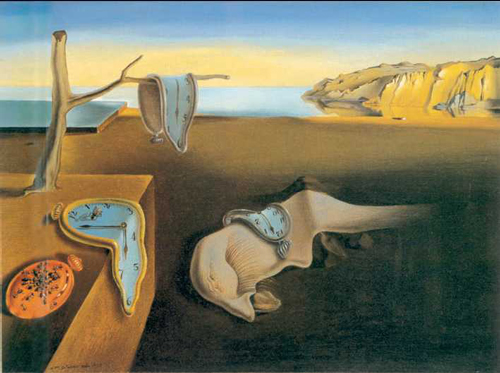
The aim of art is not just delighting man, although such role of art is also significant. Art cures, inscribes into history, gives answers to philosophical questions, evokes love and hatred. Art is a universal language, understandable by people of all religions and cultural traditions, as it refers not to common sense, but to feelings and emotions.
There are many different kinds of art. But the development of any art is based on improvement of primary element, whether it is a sound, a word, or a matter. But the most effective thing is a masterpiece, combining different kinds of art. The watchmakers chose such things indeed.
Many manufactories created their masterpieces, inspired by a piece of music or a picture. Consequently, the connoisseurs of those kinds of art had a possibility to acquire wrist watches that would reflect their tastes and constantly remind of beauty.
A number of specialists – enamellers, engravers, jewelers, sculptors – embody the ideas of designers. However, the result strikes imagination. Due to unique design and complicated performance such wrist watches become a part of museum exhibits along with other pieces of art. The subjects of watch appearances tell us about this or that idea of beauty, prevailing at a certain period of time. All this dictates size and form of case, design colors, used by the most popular men of art. But sometimes this choice can be subjective. Many masters, making wrist watches, listen to their personal preferences and, thereby, create an individual face for their brand. The more different the pieces of art decorating wrist watches, the more various the ways of changing a time meter into a piece of human cultural heritage. The most common method is experimenting with the form and the color of case or strap.
Fine arts in watch design
.jpg) Fine arts adorned Fine arts adorned.jpg) people’s life even in prehistoric times. The primitive learned to create various wall paintings or adorn everyday objects. Of course, those naïve paintings have little in common with the masterpieces of modern artists, but they pictorialized people’s life too, in a specific way though. people’s life even in prehistoric times. The primitive learned to create various wall paintings or adorn everyday objects. Of course, those naïve paintings have little in common with the masterpieces of modern artists, but they pictorialized people’s life too, in a specific way though.
Over many centuries the talented artists, sculptors, and architects have been thoroughly reflecting the features, specific for their time, obeying the famous catchword, once said by Faust in Goethe’s work of the same name, “Stop, Moment! You’re so beautiful!”. But their creations are often beyond the time. The watchmakers invented the best way to show that feature of works of art – to transfer the miniature copies of immortal pictures to the watch dials.
Enamel miniature appropriates for realizing this bold idea best of all. Of course, the wrist watches could be simply painted, but the paint is inferior to this material in its characteristics. The main qualities of colorful vitreous coating are rich coloristics and durability of created picture.
The creation of enamel miniatures is a quite complicated process, which can’t do without skillful hands and keen sight. It requires about 200 hours of laborious work. But when the picture by a famous artist has to be transferred to a coin-sized dial, the masters resort to some tricks.
At first a model of picture is prepared. Usually it is made by using the picture’s photo. A master pencils the dial’s design with a hole for hands at a scale of 1:5. The picture is transferred from the design into the model through a so-called lattice technique. Strictly speaking, the model is broken into segments with check points to provide exact picture, then the master transfers it to the future dial by parts. When the work is done, the points are carefully removed.
Enamel is applied by the thinnest brushes of marten. They are very thin and often consist of only one hair, however, there are many types of them. To create only one reproduction, a master might need up to twenty different brushes. Besides, such work can’t be done without special binocular loupe. In the beginning the enameller chooses a dominating color, applied uniformly to the dial’s model as a base. It helps the reproduction not to be translucent, but remind of its prototype by its structure. Then the enameller covers the model with the rest tones by turns to achieve the appropriate range of colors. And only after that he starts applying the picture’s layers. The finished dial seems to come out as three-dimensional as the pictures by Rembrandt. His contemporaries joked that the people he was portraying could be caught up by their noses – so thickly the strokes of paint were laid by the artist. However, the thickness of such work doesn’t usually exceed 0,05 mm. Then the dial undergoes several stages of drying in a special furnace, and it is coated with several layers of lacquer and dried during a day. Afterwards the small picture is set in its permanent residence – the wrist watch.
Miniatures by Velasquez and Tiziano from Jaeger-LeCoultre
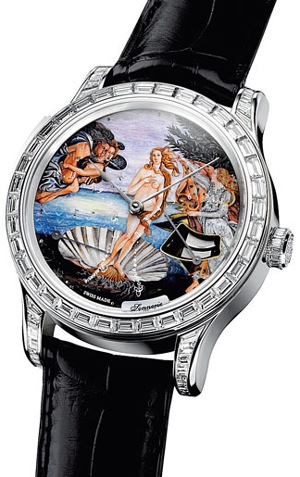 Wrist watches are made for Wrist watches are made for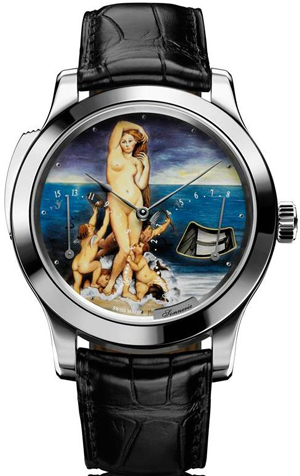 people indeed. In this respect the manufacturers’ interest in fine arts of Renaissance is rather logical. Anthropocentrism, regarding man and his needs as of paramount importance, prevails in the European culture just at the Renaissance (from the beginning of XIV century to the last quarter of XVI century). The humanistic tendencies in art reflected, first of all, in colors and subjects, often adopted from ancient culture. people indeed. In this respect the manufacturers’ interest in fine arts of Renaissance is rather logical. Anthropocentrism, regarding man and his needs as of paramount importance, prevails in the European culture just at the Renaissance (from the beginning of XIV century to the last quarter of XVI century). The humanistic tendencies in art reflected, first of all, in colors and subjects, often adopted from ancient culture.
Whether anthropocentrism has inspired the craftsmen from Jaeger-LeCoultre for reproduction of Renaissance pieces of art at the dials of their watches or the designers simply have liked those pictures, but the collection “Master Minute Repeater Venus” is devoted to such works indeed.
One wrist watch from this series is adorned with an amazing miniature of reproduction “The Venus of Urbino” (1538) by the famous Italian artist Tiziano Vecellio. It was ordered by Guidobaldo II Della Rovere, the Duke of Urbino. According to a version, his fiancée Julia Varano is depicted at this picture. By another version, Tiziano presented his beloved in the image of Venus. However, whoever this woman is in reality, the artist’s brush made her an ideal of beauty, endowing her with indispensable attributes of attractiveness by standards of that epoch: blond hair and curvy physics. Tiziano’s Venus holds a rose in her hands – a symbol of beauty and love.
That picture gave birth to many imitations, the most famous of which became “Olympia” by Edouard Manet. But the wrist watch from Jaeger-LeCoultre with enamel miniature on its dial became one of the most extraordinary variations on the theme of “The Venus of Urbino”. The reproduction by Tiziano is set in the 50-m water-resistant case of round form, made of 950 platinum, the diameter of which makes up 43 mm. Apart from hour and minute hands, this model is provided with two retrograde scales, indicating the power reserve and the spring tension. The hands are put into action by caliber JLC 947 of manual winding, equipped with the power reserve of as many as 15 days. The designers of Jaeger-LeCoultre chose a modest leather strap of black color with unfolding buckle for that model.
The collection “Master Minute Repeater Venus” also includes timepieces, reproducing the works by other great artists of Renaissance. They are “The Venus with a Mirror” by Diego Velasquez, and the beautiful enamel miniature on the theme of “The Venus Anadyomene” by Jean Auguste Dominique Ingres, and the famous “The birth of Venus” by Sandro Botticelli, and the picture “The Breath of Venus” by Alexandre Cabanel. Apart from dials, the watches from this collection differ by the material, used for making their cases: platinum or 18-carat pink gold.
Perhaps, such watches don’t strike imagination by plenty of complications, but their main value consists in something else. Every time, looking at his wrist, the owner of such watch doesn’t see only the indications of hands, but also comprehends creative power of mind.
.jpg)
“Baroque” watches from Angular Momentum
 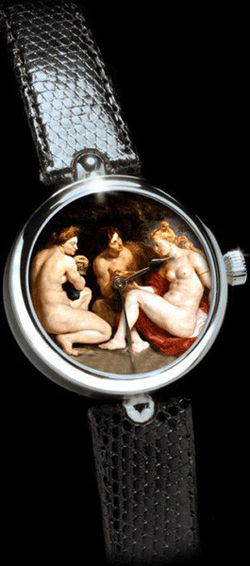 The watch manufactory The watch manufactory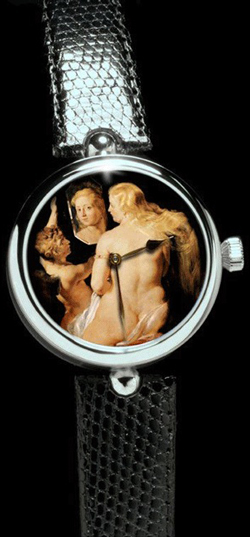 “Angular Momentum” from Bern hasn’t been existing for a long time, but it has managed to achieve world popularity over a quite short period. The main credit for this goes to the designers. Their inexhaustible fantasy allows Angular Momentum manufacturing the wrist watches that could be referred to pieces of art without any qualms. At that the masters usually don’t experiment with the case form. The main advantage of Angular Momentum is enamel dials, adorned with the pictures of icons, birds, naked women or even Russian tsars. “Angular Momentum” from Bern hasn’t been existing for a long time, but it has managed to achieve world popularity over a quite short period. The main credit for this goes to the designers. Their inexhaustible fantasy allows Angular Momentum manufacturing the wrist watches that could be referred to pieces of art without any qualms. At that the masters usually don’t experiment with the case form. The main advantage of Angular Momentum is enamel dials, adorned with the pictures of icons, birds, naked women or even Russian tsars.
The watches “Verre Èglomisé” from “Allegory & Mythology” line became real masterpieces. Their dials represent small copies of pictures by Holland baroque artists. The works of Flemish artist Piter Paul Rubens, famous for his hedonistic subjects and rich color range, take a special place.
Angular Momentum offers three variants of watches with reproductions by the great artist. The dials depict the pictures by Rubens “Two satyrs” (1618 — 1619), “Venus, Cupid, Bacchus and Ceres” (1611 — 1612), and “The Toilet of Venus” (1612 — 1615). For making these enamel miniatures the masters used a special technique “Verre Èglomisé”, which gave the name to the whole collection. The artist takes a glass plate and paste golden or silver foil on its back side, and then he paints it. Such method of decoration was especially popular in the furniture design in the 20-30s of past century. Today, thanks to the craftsmen of Angular Momentum, the miniatures with the pictures by Rubens moved to the round steel cases of 42 mm in diameter. They are provided with self-winding movements and black leather straps.
The wrist watches from “Verre Èglomisé” collection by Angular Momentum and the Baroque have the same specific features: contrast and dynamics, vividness and pomp. One can say that these unusual watches combine real practical purpose with phantom art design, reflecting the different styles fusion tendency of that time.
Colorful life from Laks
The Austrian company “Laks” is specialized in the manufacture of watches, imbuing their owner’s life with bright colors and impressions. Since 1986, when the manufactory started functioning, it has managed to become an example of the most fashionable tendencies of the watch market.
However, the wrist watches from Laks are not just a bright design. Each detail of their quartz movement is finished and adjusted at a maximum accuracy, providing best quality. The cases are made of strong steel. The scratch-proof sapphire glasses provide supplementary protection from damages. Due to their reliability and quite democratic price the watches of Laks brand gained popularity fast. During a long time they remained popular in many countries of Eastern Europe, European Union, and Asia. Today the brand “Laks” is available in Japan, Korea, Taiwan, Australia, America, and Switzerland.
As for the design, the sport line with the use of famous pictures’ reproductions is the most interesting. Moreover, the designers of Laks didn’t limit the flight of their fantasy by only one artist or tendency and took the most outstanding and recognizable examples from each style and epoch. This list includes the following works: postimpressionist Vincent Van Gogh – “Sunflowers” (1888), awe-inspiring “Café terrace at night” (1888), “Irises” (1889), and self-portrait of 1887; Leonardo Da Vinci from Renaissance with his famous “Mona Liza” (1505-1506) and “Vitruvian Man”; representative of West-European Renaissance Albrecht Durer with his “The praying hands” (about 1508) and “Hare” (1502); Michelangelo Buonarrotti with the copy of fresco “The creation of Adam” (about 1511); parts of pictures by impressionist Pierre-Auguste Renoir; fragment of “The Sistine Madonna” (1512 — 1513) by Raphael Santi; “The star” (1878) by impressionist Edgar Degas with the strap, finished by pink frill reminding of small ballet tutu, and others. Among various subjects everyone will find the picture that meets his aesthetic taste best of all.
The wrist watches “Laks” are issued in cases of two variants: round case of 34 mm in diameter or rectangle of 43x33-mm size. The thickness is the same: 8 mm. These watches have a specific design – the picture’s reproduction isn’t limited by the dial. The picture is continued at the soft removable strap, which can be replaced by a stricter one.
.jpg)       
Wrist watches and sculptor – a tandem from Dominic Wilcox
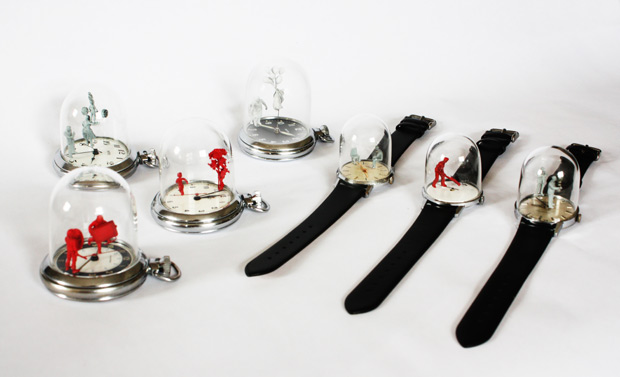 Sculptor is an integral part of fine art. Many people are used to take this genre as something monumental, impressive. Perhaps, that is the reason why the wrist watches are rarely adorned with sculptor elements. Besides, one shouldn’t forget about comfort and compactness, so necessary features of a wrist device. The watches are simpler to be decorated with picture reproductions, than with volumetric figures. But that doesn’t mean horlogerie and sculptor have nothing in common. Sculptor is an integral part of fine art. Many people are used to take this genre as something monumental, impressive. Perhaps, that is the reason why the wrist watches are rarely adorned with sculptor elements. Besides, one shouldn’t forget about comfort and compactness, so necessary features of a wrist device. The watches are simpler to be decorated with picture reproductions, than with volumetric figures. But that doesn’t mean horlogerie and sculptor have nothing in common.
An artist from the USA Mike Libby united those concepts in a very specific way. He creates miniature sculptors from wrist watch details and dead insects. Each of them is unique, as all of them are made by hand. For creating these unusual sculptors Mike uses the insects, which do not refer to endangered species, that he looks for all over the world – in Africa, China, Brazil. He completes them with metallic details from broken wrist or pocket watches. Mike willingly sells his extraordinary creations by Internet.
However, such sculptor still has one significant disadvantage – it is completely lack of functionality. Dominic Wilcox, designer, artist and inventor from Britain, managed to avoid that. He trained not only in England, but also in Japan, which is considered to be a specific site of pilgrimage thanks to the trendy minimalism, especially honored there. Wilcox combines it with his delicate British sense of humor. As a result, he has made a whole series of mechanical watches, adorned with miniature sculptors under convex glasses of dials. The series includes the following works by Wilcox: “London Looter”, “The beautiful game”, “Hide ’n’ seek”, “Watch Sweeper”, “The Unrequited Handshake”, “The Sitting Man”, “Adventures of a young vegetarian”, and “Oblivious iPhone User”.
The miniatures are created on the base of vintage watches. The small figures of people play scenes from everyday life. Wilcox had to spend a lot of sweat to make his creations work as he has planned. Depending on the figures’ form and composition’s subject he often had to change a little bit the hands’ angle of slop and add new details. As a result, the scenes are animated. The figure fixed at the second hand moves quickly along the circle, while the minute hand rotation isn’t so visible. Therefore, its figure seems static. The figures are under small glass domes, created by the companies “National Glass Centre” and “Wearside Glass Sculptures” by the order of Wilcox.
The artist admitted that his main aim was creating funny miniatures, which would reflect the routine and remind of an idea about endlessly repeated events in a cheerful unobtrusive way.
Always be in the mask – destiny of watches “Les Masques” from Vacheron Constantin
.jpg) Men of various arts often referred to the cultural heritage left us by our remote ancestors. The watchmakers from Vacheron Constantin, who keep its ancient traditions, haven’t become an exception. The company often addressed to different kinds of art and, finally, it turned its attention to the primitive art. Especially that there was a good reason to go back to the history – the 250th jubilee of the manufactory. Men of various arts often referred to the cultural heritage left us by our remote ancestors. The watchmakers from Vacheron Constantin, who keep its ancient traditions, haven’t become an exception. The company often addressed to different kinds of art and, finally, it turned its attention to the primitive art. Especially that there was a good reason to go back to the history – the 250th jubilee of the manufactory.
The work on the collection “Les Masques” started from collaborations of Vacheron Constantin leadership with the founder of the Museum of primitive art in Geneva Jean-Paul Barbier-Mueller. The watchmakers faced a difficult task: to persuade him to provide some exhibits for studying and creation of miniature moulds that would take much time.
As a result, 12 antique masks representing different cultures were chosen from Barbier-Mueller’s collection. Then the specialists of Vacheron Constantin started designing the future watches, selecting materials and finishing technique for the primitive sculptor models. The craftsmen had to spend over 100 hours to make only one miniature copy of mask.
The first of four devices from the series of wrist watches “Les Masques” was presented by the manufactory in 2007. The collection was opened by masks from Indonesia, China, Congo, and Alaska. The cases of these watches are round and made of gold of various tones and noble platinum. They don’t have hands. They are replaced by four rotating disks, put into action by a specially finished caliber 2460 G4 with self-winding function from Vacheron Constantin. The dial from sapphire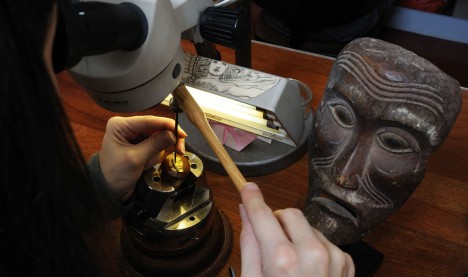 glass is equipped with four special apertures, indicating date, week day, hour, and minute. The masks themselves are situated at nontraditional places – right on the glass in the middle of dial. It seems that the mask as if soars above the watch case surrounded by sputtered alluring poems by French poet Michel Butor. These words are devoted to the prototype of a primitive art piece, kept in the museum, and you can read them only when the light falls on the dial at a certain angle. glass is equipped with four special apertures, indicating date, week day, hour, and minute. The masks themselves are situated at nontraditional places – right on the glass in the middle of dial. It seems that the mask as if soars above the watch case surrounded by sputtered alluring poems by French poet Michel Butor. These words are devoted to the prototype of a primitive art piece, kept in the museum, and you can read them only when the light falls on the dial at a certain angle.
The following two years were marked with the issue of new sets “Les Masques” with different masks. Each model is released in a number of 25 pieces, and they are available only in a set from four different timepieces.
Vacheron Constantin and Babier-Mueller continued their collaboration. Under the auspices of the watch company, in 2010 the cultural fund of the Museum of primitive arts was established. It is aimed at keeping the cultural heritage of little-known and disappeared nations, and also at financing and supporting of various anthropological expeditions and publication of related science materials. This is another way for the manufactory “Vacheron Constantin” to pay tribute to the variety of beauty on a scale of all mankind. It has supported several expeditions, the results of which will be published soon. Thanks to the executed work people will know more about the African nation Kaan from Burkina Faso and the tribes of Mona, Koyaka, and Wan from the central regions of Cote D’Ivoire.
Design novelty from Fossil and Philippe Starck
 Interior design relates to architecture or sculpture quite indirectly, and it’s not always considered to be a kind of art. However, today we have masters of that art, who may compete with the great artists of past epochs in glory and demand. Interior design relates to architecture or sculpture quite indirectly, and it’s not always considered to be a kind of art. However, today we have masters of that art, who may compete with the great artists of past epochs in glory and demand.
For example, French designer Philippe Starck became famous around the world for industrial design and manufacture of serially produced industrial goods. He started his creative activity in 1968 from making inflatable things, and today his works are constantly exhibited in the Design Museum in London and the Paris Museum of Decorative Arts. The multicolored plastic chairs, designed by Starck, are known all over the world. We see their prototypes at the summer areas of cafes, having no idea that these are specific pieces of art.
But the American watch company “Fossil” noticed and valued the creative approach of Starck. That brand was always popular among young, bold and progressive people thanks to its extraordinary design. The love for various experiments led Fossil to cooperation with Philippe Starck. As a result, the wrist watches, being traditional accessories, have become both functional due to complication and stylish. Both sides gained from that experiment: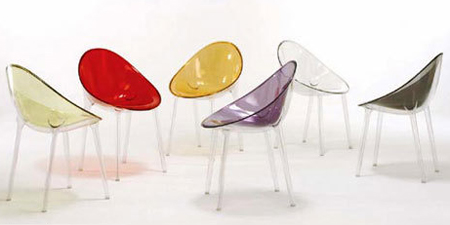 Starck got an interesting work experience and a chance to evolve his new talents, and the company “Fossil” confirmed its glory, as a brand that opened a new page of style in the history of wrist watches. Starck got an interesting work experience and a chance to evolve his new talents, and the company “Fossil” confirmed its glory, as a brand that opened a new page of style in the history of wrist watches.
The designer staked on sport trend. The main feature of these watches is an original strap “HARDSTARCK” from polished stainless steel. All models are provided with clear digital displays. Besides, Fossil offers two models for those, who always have to adjust hours in accordance with different time zones: “Palindrome Too” and “Veild”. They are provided with two dials, indicating two time zones at once. The hands are replaced by the marks “+” and “-“. The cases of novelties are steel, the straps are made of polyurethane. These watches are designed in two color variants: black with silver or orange with grey.
Fossil didn’t forget about ladies either. They can enjoy the polyurethane straps “HARDSTARCK” of vivid colors with polished cases and digital dials. The inversion dial is protected with transparent crystal glass, the case is dull. Such sport watches from Fossil are provided with alarm, timer, illumination, water resistance up to 5 ATM. 24- and 12-hour formats of time indication are available.
 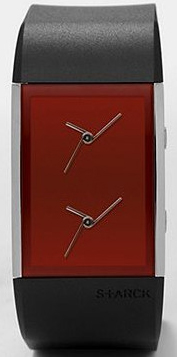    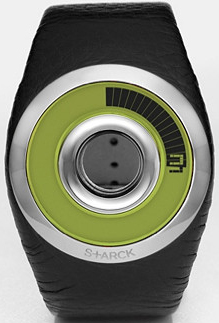 .jpg)
Pop Art novelties from Andy Warhol and 01TheOne
.jpg) The end of 1950s of past century The end of 1950s of past century.jpg) was marked by the bloom of one of the most outstanding and controversial tendencies in fine art named “Pop Art”. This term derives from “popular art”. The idea of that trend is still discussed. Many people doubt the belonging of pop art to kinds of art. However, that doesn’t decrease the high demand for it today. was marked by the bloom of one of the most outstanding and controversial tendencies in fine art named “Pop Art”. This term derives from “popular art”. The idea of that trend is still discussed. Many people doubt the belonging of pop art to kinds of art. However, that doesn’t decrease the high demand for it today.
Pop Art consists in reconsideration of various mass products’ images, which are used every day. An image adopted from mass culture is placed into unusual context by an artist. At that some details (scale of image, material it is made of) can be changed. The artist doesn’t strive for hiding techniques and art methods, applied in the work, unrevealing all secrets. So, the stereotypes, established in modern man’s mind long ago, are destroyed. The figurative language of Pop Art is sometimes paradoxical. The works of this style have unusual forms and images, follow unwonted traditions, and sometimes they are created of the most unexpected materials. This combination of intentional indifference with challenge makes Pop Art picture, sculptures and interiors extraordinarily vivid and loud. Due to these features, the designers of accessories, including the manufacturers of wrist watches, paid their attention to them.
The German brand “01TheOne” offers original time meters, designed for independent and free people. The binary watch from “Art Edition” collection is made in Pop Art style, that’s why it immediately attracts the attention. Its rectangular steel case of 42õ48 mm is provided with brown leather strap with classic buckle. The designers of 01TheOne adorn watches with enamel pictures, created by a talented artist Kristel Lerman. She writes stunning pictures in Pop Art, reminding of vivid graffiti. Two columns of red light diodes, performing time indication, are covered by the display’s polarized glass. The minutes are showed at the right side, the hours – at the left. The number of flashing .jpg) light diodes tells about the quantity of elapsed light diodes tells about the quantity of elapsed(1).jpg) time intervals. The date is indicated in the same way. To activate this function you need to push twice a special button. The wrist watch of 01TheOne has a quartz movement and remains water-resistant at 30 meters of depth. It will be good, first of all, for young people, following fashion trends. time intervals. The date is indicated in the same way. To activate this function you need to push twice a special button. The wrist watch of 01TheOne has a quartz movement and remains water-resistant at 30 meters of depth. It will be good, first of all, for young people, following fashion trends.
We can’t speak about Pop Art without mentioning the name of the world-known artist and photographer Andy Warhol. You can hardly meet a person who has never seen his famous pictures “Campbell’s Soup Cans” and “Green Coca-Cola Bottles”. They were created by Warhol in far 1962, but they are still extremely popular till nowadays. Besides, he managed to cooperate with many celebrities of that epoch, such as Elvis Presley, Jim Morrison, and Elizabeth Taylor. “The Marilyn Diptych” by Warhol, created after Monroe’s death, became especially popular.
Finally, the creative work of this wonderful and original artist is able to pass ahead of its time and simply help to measure it. Today the pictures by Warhol adorn wrist watches. They are equipped with quartz movements. The watches are available in round and rectangular cases. In an effort to make their prices more democratic like the prices on other popular art objects, the watches are made of practical aluminum and stainless steel, and the straps are made of leather. The case is water-resistant at 30 m depth; the dial is protected with mineral glass.
But the main advantage of such watches is, first of all, outstanding design. They chequer by specific Warhol’s vivid and rich color, sometimes even “acid”, although there are models with quite restrained color range. Anyway, the picture subjects are quite different and unexpected: classic Marilyn Monroe and bananas, or airplanes, hot-dogs, birds, diamonds, or simply unusual combinations of bright color spots. In any case, such accessory won’t leave anyone indifferent.
Dedication to opera from Vacheron Constantin
.jpg) .jpg) Speaking about the Speaking about the.jpg) connection between horlogerie and music, of course, we will think about repeaters. But even the most beautiful and melodic strike, cased in a watch, won’t reproduce completely the beauty of classic masterpieces by the great composers of the past. Solving this problem, the masters try to experiment with the appearance again. connection between horlogerie and music, of course, we will think about repeaters. But even the most beautiful and melodic strike, cased in a watch, won’t reproduce completely the beauty of classic masterpieces by the great composers of the past. Solving this problem, the masters try to experiment with the appearance again.
Many designers approach to a solution of this problem with the sense of humor. For example, the Russian brand “Miusli” offers wrist watches with stainless steel cases and black leather strap, provided with Japanese quartz movement “Miyota 2035” from Citizen. Their dials are adorned with various music attributes: Cassette Red — audio cassette, Vinyl — vintage vinyl record, Music — flower pattern and musical notation of unknown melody.
Another funny model from the Japanese – a quartz watch in the form of bass guitar. The case in the form of deck is made of light and durable anodized aluminum; the strap is made of silicone.
Such watches hardly claim to a place in the history of horlogerie, they sooner perform an entertaining function. But the Genevan manufactory “Vacheron Constantin” approaches seriously to discussing of any topic. As far as music is concerned, the watchmakers have referred to its most beautiful and noble embodiment – classic opera.
Vacheron Constantin became famous long ago as a generous patron, ready to support any true kind of art. Since 2007 it has been an official sponsor of an organization under the title “Opera national de Paris”. In November, 2010, the organization, friend of Paris opera and ballet, “Association pour le Rayonnement de l'Opera National deParis” (AROP) marked its 30th anniversary. 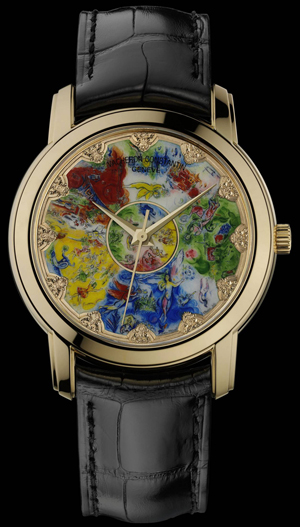 Vacheron Constantin Vacheron Constantin dated the release of the first watch from “Metiers d'Art” collection - Chagall & l'Opera de Paris, dedicated to the great composers – for that event. Its main advantage is the dial with enamel miniature, duplicating the painting at the ceiling of the Opera Theater Garnier in Paris, written by Marc Chagall. The work was ordered by the Minister of France Henri Malrot. In 1963 Chagall, who had already turned 77, accepted his offer and started his work. However, Malrot’s decision evoked sooner discontent than approval of the French people. And they had pretty enough reasons for that. Some people didn’t like that a modern artist got down to the architecture painting of the XIX century. Others were indignant at the fact that the national heritage of France was trusted to the Russian Jewish. dated the release of the first watch from “Metiers d'Art” collection - Chagall & l'Opera de Paris, dedicated to the great composers – for that event. Its main advantage is the dial with enamel miniature, duplicating the painting at the ceiling of the Opera Theater Garnier in Paris, written by Marc Chagall. The work was ordered by the Minister of France Henri Malrot. In 1963 Chagall, who had already turned 77, accepted his offer and started his work. However, Malrot’s decision evoked sooner discontent than approval of the French people. And they had pretty enough reasons for that. Some people didn’t like that a modern artist got down to the architecture painting of the XIX century. Others were indignant at the fact that the national heritage of France was trusted to the Russian Jewish.
Despite all loose talk, on the 23rd of September, 1964, Marc Chagall presented the finished fresco to Malrot and over two thousand invited guests. The true adornment of Garnier Opera Theater took totally 220 sq. meters. Chagall spent over 400 pounds of paint. The canvas consisted of 5 parts, fixed on polyester panels, specially installed on the ceiling’s plafond. An incredible colorful fresco reminds of amazing flower with multicolored petals. Chagall, famous as a matchless colorist, emphasized 5 main colors: white, yellow, blue, red, and green. Each petal is divided by two famous composers with their eternal works. Chagall remembered Verdi, Gluck, Bizet, Musorgsky, Ravel, Berlioz, and other. Of course, he couldn’t pass by his favorite – Mozart. Besides, the fresco also includes images of famous actors and dancers.
According to the correspondent of “New York Times” in Paris, who was at the presentation of this creation by Chagall, the luxurious crystal chandelier in the middle of the ceiling was out, when people came into the hall. Then the whole corps de ballet came out to the scene, the favorite music of Chagall – “The Jupiter Symphony” by Mozart – went from the orchestra pit. When the orchestra played two final bars, the chandelier came on, lighting the fresco. The audience, including the members of commission that was against Malrot’s choice, burst into rapturous applause.
The watch “Chagall & l'Opera de Paris” from Vacheron Constantin creates the same striking impression. The round case from yellow gold of only 41 mm in diameter holds a wonderful copy of the famous fresco by Chagall, made by the master-enameller Anita Porchet. During three months she was working on that miniature, reproducing the picture’s fragments at the dial’s model, coated with white enamel, using the thinnest brush, consisting of only a pair of marten hairs. When the copy was finished, the jeweler Jeanne Ulrich began the work. She created 12 nymphs, performing hour markings, and each of them is endowed with personal expression.
The watch “Metiers d’Art Chagall & l’Opera de Paris” is created in a single copy not for sale. Vacheron Constantin is planning to release another 14 models, each representing only a part of the fresco and devoted to only one author and his work. The creativity of watchmakers turned “Metiers d’Art Chagall & l’Opera de Paris” into a true masterpiece, deserving its prototype.
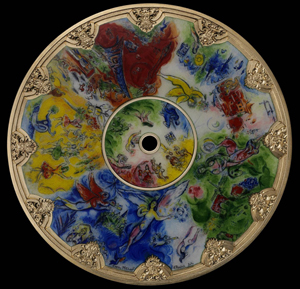 
Watches-icons from Bovet
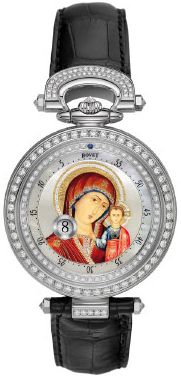 The Swiss watch manufactory “Bovet” is famous The Swiss watch manufactory “Bovet” is famous.jpg) for the art design of its watches. You can’t speak about enameling, not mentioning the name of this company. Over the history of Bovet the dials were adorned with the pictures of animals, birds, flowers, the pictures by famous artists, Japanese geishas, and dragons. However, we are especially interested in unusual models of that brand, adorned with the copies of icons. for the art design of its watches. You can’t speak about enameling, not mentioning the name of this company. Over the history of Bovet the dials were adorned with the pictures of animals, birds, flowers, the pictures by famous artists, Japanese geishas, and dragons. However, we are especially interested in unusual models of that brand, adorned with the copies of icons.
No wonder the Swiss watchmakers took the Russian images of saints as a base of their dials. Religion has become almost a popular trend after a long-time censure during communism. So, various things of everyday use with religious design are in demand. Besides, Russia was always glorious for its icon-painting traditions.
Bovet has offered unique wrist watches with enamel copies of icons to its believers — Bovet Our Lady of Kazan and Bovet Our Lady of Vladimir. Both models have round cases from 18-carat gold, white or rose. Their diameter makes up 39 mm, the water resistance — up to 30 m. The watches are provided with automatic movements with a power reserve of 48 hours. Their bezel is incrusted with a row of white diamonds, and the crown is adorned with a blue “cabochon” sapphire.
The craftsmen of Bovet have created a unique accessory. It combines functionality of time meter with spirituality of religious art.
By the way, it’s not the first attempt of reproducing Madonna on a dial for Bovet. However, earlier such images were copied not from icons, but from canvas of great artists – for example, “The Madonna and Child” by Rafael.
The wrist watches with Our Lady from Bovet are a perfect combination of material and spiritual values.
To be continued…
|




.jpg) Fine arts adorned
Fine arts adorned.jpg) people’s life even in prehistoric times. The primitive learned to create various wall paintings or adorn everyday objects. Of course, those naïve paintings have little in common with the masterpieces of modern artists, but they pictorialized people’s life too, in a specific way though.
people’s life even in prehistoric times. The primitive learned to create various wall paintings or adorn everyday objects. Of course, those naïve paintings have little in common with the masterpieces of modern artists, but they pictorialized people’s life too, in a specific way though.  Wrist watches are made for
Wrist watches are made for people indeed. In this respect the manufacturers’ interest in fine arts of Renaissance is rather logical. Anthropocentrism, regarding man and his needs as of paramount importance, prevails in the European culture just at the Renaissance (from the beginning of XIV century to the last quarter of XVI century). The humanistic tendencies in art reflected, first of all, in colors and subjects, often adopted from ancient culture.
people indeed. In this respect the manufacturers’ interest in fine arts of Renaissance is rather logical. Anthropocentrism, regarding man and his needs as of paramount importance, prevails in the European culture just at the Renaissance (from the beginning of XIV century to the last quarter of XVI century). The humanistic tendencies in art reflected, first of all, in colors and subjects, often adopted from ancient culture.